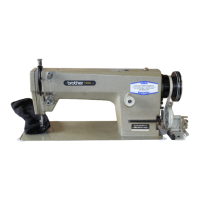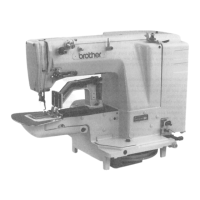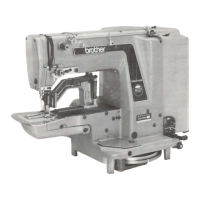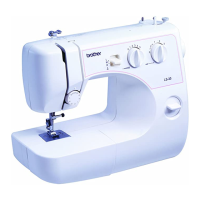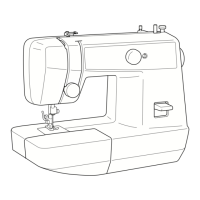Why does the upper thread keep breaking on my Brother LK3-B430E MARK II?
- PPeter BrownAug 17, 2025
If the upper thread breaks on your Brother Sewing Machine, try adjusting the upper thread tension.

Why does the upper thread keep breaking on my Brother LK3-B430E MARK II?
If the upper thread breaks on your Brother Sewing Machine, try adjusting the upper thread tension.
What to do if the lower thread breaks on my Brother LK3-B430E MARK II Sewing Machine?
If the lower thread breaks on your Brother Sewing Machine, try adjusting the tension of the lower thread.
Why is there insufficient lower thread wound to one side on my Brother LK3-B430E MARK II?
If there is insufficient lower thread wound to one side on your Brother Sewing Machine because of an improper position of the bobbin presser, adjust the height of the bobbin presser.
How to reinstall needle in Brother LK3-B430E MARK II?
If the needle is improperly installed in your Brother Sewing Machine, it may cause issues. Reinstall the needle, ensuring the long groove faces the front.
How to fix sluggish link operation on Brother Sewing Machine?
If the link operation on your Brother Sewing Machine is sluggish, try adjusting the solenoid position or applying grease to the clamp.
Why does the thread wiper obstruct the needle tip on my Brother LK3-B430E MARK II?
If the thread wiper obstructs the needle tip on your Brother Sewing Machine due to improper thread wiper operation, adjust the height of the thread wiper.
What to do if work clamp operation is sluggish on Brother LK3-B430E MARK II Sewing Machine?
If the work clamp operation is sluggish on your Brother Sewing Machine, adjust the height of the work clamp to 17 mm or less.
What to do if the link does not return on Brother LK3-B430E MARK II?
If the link does not return on your Brother Sewing Machine, adjust the solenoid position.
Why is the lower thread wound to one side on my Brother LK3-B430E MARK II?
If the lower thread is wound to one side on your Brother Sewing Machine due to an improper height of the tension stud, adjust the height of the tension stud.
How to fix improper sliding of presser plate on Brother LK3-B430E MARK II?
If the presser plate is sliding improperly on your Brother Sewing Machine, apply grease to the presser plate and the presser arm lever plate.
| Brand | Brother |
|---|---|
| Model | LK3-B430E MARK II |
| Category | Sewing Machine |
| Language | English |
Explains the meanings of safety indications and symbols used in the manual.
Details the ambient temperature and humidity requirements for machine operation.
Provides safety guidelines and procedures for installing the sewing machine.
Describes the operation of the needle bar, thread take-up, lower shaft, and shuttle race.
Explains the function and operation of the work clamp lifting mechanism.
Details the combined operation of the work clamp lifter and thread wiper.
Explains the X and Y direction feed mechanisms responsible for pattern creation.
Describes the components and operation of the thread trimming system.
Details the thread nipper mechanism, including manual operation and thread trimming.
Explains the functioning of the thread take-up mechanism.
Details the procedure for removing the various covers of the sewing machine.
Outlines the steps for disassembling the presser arm mechanism.
Provides instructions for removing the shuttle hook assembly and related parts.
Details the process of disassembling the needle bar and its related components.
Explains the steps for disassembling the upper shaft and its associated parts.
Guides the user through the disassembly of the lower shaft mechanism.
Details the first part of the feed mechanism disassembly process.
Continues the feed mechanism disassembly instructions.
Completes the feed mechanism disassembly instructions.
Provides the steps for disassembling the presser mechanism.
Details the disassembly of the thread wiper mechanism.
Explains the procedure for disassembling the thread nipper mechanism.
Guides the user through the disassembly of the thread take-up mechanism.
Details the steps for disassembling the thread trimmer mechanism.
Details the first part of the thread trimmer mechanism assembly.
Explains the procedure for assembling the thread nipper mechanism.
Details the first part of the thread wiper mechanism assembly.
Guides the user through the assembly of the thread take-up mechanism.
Details the steps for assembling the presser mechanism.
Details the first part of the feed mechanism assembly process.
Continues the feed mechanism assembly instructions.
Completes the feed mechanism assembly instructions.
Explains the steps for assembling the upper shaft and its associated parts.
Details the process of assembling the needle bar and its related components.
Guides the user through the assembly of the lower shaft mechanism.
Details the second part of the thread trimmer mechanism assembly.
Details the second part of the thread wiper mechanism assembly.
Explains the assembly of the shuttle race mechanism.
Details the steps for assembling the presser arm mechanism.
Details the procedure for attaching the various covers of the sewing machine.
Explains how to adjust the needle bar to the correct height.
Guides the user in adjusting the needle bar lift stroke for optimal performance.
Details how to adjust the driver needle guard for correct needle contact.
Explains how to set the correct clearance between the needle and the shuttle hook.
Guides the user on adjusting the shuttle race thread guide for proper needle centering.
Explains how to adjust the maximum lift amount of the work clamp.
Details the procedure for adjusting the position and clearance of the thread wiper.
Guides on adjusting the thread take-up lever stroke for thread trailing.
Explains how to adjust the movable knife for proper thread trimming.
Provides instructions for replacing the movable and fixed knives for clean thread cutting.
Details the procedure for adjusting the engagement of the movable and fixed knives.
Explains how to adjust the position of the driving lever stopper for thread trimming.
Guides on adjusting the position of the thread trimmer driving lever.
Details how to adjust the position of the thread trimming solenoid.
Explains how to adjust the play in the drive system for smooth operation.
Guides on adjusting the position of the presser solenoid for proper work clamp operation.
Details how to adjust the sensor perceive plate for correct detection.
Explains how to set the home position for the X and Y axes.
Guides on adjusting the needle's stop position after sewing.
Details how to adjust the V-belt tension for optimal machine performance.
Highlights safety precautions to be taken when working on the electrical control box.
Identifies and briefly explains the main electrical components within the control box and panel.
Lists fuse types, their part codes, and the symptoms when a fuse blows.
Details connector positions and emphasizes checking for proper connections to prevent issues.
Explains the functions of DIP switches on the operation panel and control box.
Describes how to check the status of input sensors and DIP switch settings.
Explains how to check the machine's input voltage using the operation panel.
Provides a procedure to clear all memory settings and reset the machine.
Details how to check the machine's software version displayed on the panel.
Lists all error codes, their causes, and recommended remedies for troubleshooting.
Presents a flowchart to guide users through diagnosing and resolving machine issues.
Provides detailed solutions and measures for specific error codes and problems identified in the flowchart.


